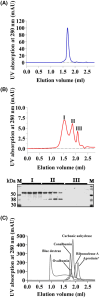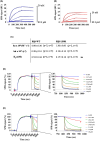Allosteric modulation of protein kinase A in individuals affected by NLPD-PKA, a neurodegenerative disease in which the PRKAR1B L50R variant is expressed
- PMID: 40244081
- PMCID: PMC12443466
- DOI: 10.1111/febs.70098
Allosteric modulation of protein kinase A in individuals affected by NLPD-PKA, a neurodegenerative disease in which the PRKAR1B L50R variant is expressed
Abstract
Protein kinase A (PKA) is a crucial signaling enzyme in neurons, with its dysregulation being implicated in neurodegenerative diseases. Assembly of the PKA holoenzyme, comprising a dimer of heterodimers of regulatory (R) and catalytic (C) subunits, ensures allosteric regulation and functional specificity. Recently, we defined the RIβ-L50R variant as a causative mutation that triggers protein aggregation in a rare neurodegenerative disease, neuronal loss, and parkinsonism driven by a PKA mutation (NLPD-PKA). However, the mechanism underlying uncontrolled PKA allosteric regulation and its connection to the functional outcomes leading to clinical symptoms remains elusive. In this study, we established an in vitro model using patient-derived cells for a personalized approach and employed direct measurements of purified proteins to investigate disease mechanisms in a controlled environment. Structural analysis and circular dichroism spectroscopy revealed that cellular protein aggregation resulted from misfolded RIβ-subunits, preventing holoenzyme assembly and anchoring through A-kinase anchoring proteins (AKAPs). While maintaining high affinity to the C-subunit, the resulting RIβ-L50R:C heterodimer exhibits reduced cooperativity, requiring lower cAMP concentrations for dissociation. Consequently, there was an increased translocation of the C-subunit into the nucleus, impacting gene expression. We successfully controlled C-subunit translocation by introducing a mutation that decreased RIβ:C dissociation in response to elevated cAMP levels. This research thus sets the stage for developing therapeutic strategies that modulate PKA assembly and allostery, thus exerting control over the unique molecular signatures identified in the disease-associated transcriptome profile.
Keywords: PRKAR1B; allostery; holoenzyme assembly; neurodegenerative disease; protein kinase A.
© 2025 The Author(s). The FEBS Journal published by John Wiley & Sons Ltd on behalf of Federation of European Biochemical Societies.
Conflict of interest statement
The authors declare no conflict of interest.
Figures









References
-
- Cadd G & McKnight GS (1989) Distinct patterns of cAMP‐dependent protein kinase gene expression in mouse brain. Neuron 3, 71–79. - PubMed
-
- Abel T, Nguyen PV, Barad M, Deuel TA, Kandel ER & Bourtchouladze R (1997) Genetic demonstration of a role for PKA in the late phase of LTP and in hippocampus‐based long‐term memory. Cell 88, 615–626. - PubMed
-
- Huang YY, Kandel ER, Varshavsky L, Brandon EP, Qi M, Idzerda RL, McKnight GS & Bourtchouladze R (1995) A genetic test of the effects of mutations in PKA on mossy fiber LTP and its relation to spatial and contextual learning. Cell 83, 1211–1222. - PubMed
MeSH terms
Substances
Grants and funding
LinkOut - more resources
Full Text Sources
Medical

